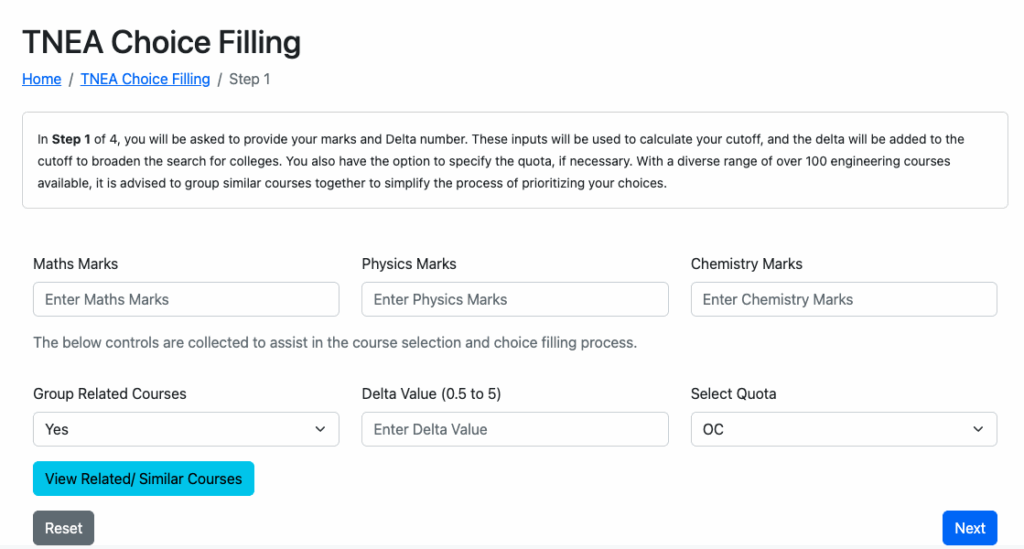Your fastest way to build a winning TNEA preference list with tneacutoff.in
If you are applying through TNEA, understanding the TNEA Choice Filling process is crucial. In this TNEA Choice Filling guide, we break it down the process into step by step. The most important task you’ll do is choice filling—deciding the exact order of courses and colleges you want. This guide walks you through the step‑by‑step workflow inside tneacutoff.in, so you can go from marks → shortlist → ranked list in minutes.
Why use tneacutoff.in for choice filling?
- Realistic shortlisting: Start with your marks/cutoff and instantly see matching options.
- Smarter grouping: Combine related branches (like CSE/AI/DS/IT) to keep your list broad without getting overwhelmed.
- Clean college intel: Browse colleges with key details (district, management type, accreditation) and drill down to courses & historic cutoffs.
- Round‑ready order: Export a tight, TNEA‑friendly preference order you can lock during counselling.
Step 1 — Enter marks in TNEA Choice Filling, and choose quota
Go to Choice Filling Workflow and start with three inputs:

- 12th Marks: Maths, Physics, Chemistry — your standard TNEA trio. We compute your cutoff.
- Delta value (0.5–5): Think of this as a flex window added to your cutoff to widen the college search (use a small delta for a focused list; higher delta to explore more).
- Quota (optional): OC/BC/BCM/MBC/SC/ST — select if it applies to you to get more relevant results.
👉 Pro move: Toggle Group Related Courses to merge similar branches (e.g., CSE, AI/ML, Data Science, IT) so you rank once, yet stay open to multiple specialisations.
Step 2 — Build your course wishlist (regular or grouped)
You’ll now shape your course preference before you touch the colleges:
- Regular mode: Pick exact branches (e.g., Mechanical Engineering, ECE, Civil).
- Grouped mode: Keep allied branches under one umbrella (e.g., the CSE family: CSE, CSE‑AI/ML, CSE‑DS, IT, Cyber Security, IoT). This keeps Plan B/C/D open without 100 extra lines in your list.
How to choose wisely
- Start with 2–4 course families you genuinely like.
- Within each family, note which specialisations you’d happily study.
- Keep at least one safe family (broader availability) along with your dream family.
Step 3 — (Optional) Explore and rank colleges with filters
During TNEA Choice Filling, students must carefully rank colleges. The tool is primarily designed to directly match the right set of colleges for your marks. But if you want more control, you can refine your list further
- Use College Finder to plug in your marks and get a first cut of matching colleges.
- Open the full Colleges directory to explore:
- Filters: District selector; browse A–Z; quick scan of management (Govt/Private/Aided) and accreditation badges.
- Deep dives: Click View Courses & Cutoffs on any college to see what they offer and how competitive each branch has been historically.
Build your order (if needed):
- Shortlist 15–40 colleges that realistically fit your rank window.
- Within each course family, drag colleges into the order you’d truly prefer if all were available.
- Sprinkle a few reach options at the top and safe options near the bottom to balance ambition with probability.
Step 4 — Finalise and export your TNEA‑ready list
You’re aiming for a clean, de‑duplicated, round‑ready sequence:
- De‑dupe smartly: In grouped mode, keep just one line per course family per college (the system will consider related branches while allotting).
- Lock your logic: Prefer course you love in a decent college over random course in a top college unless you’re sure of the trade‑off.
- Export/Copy: Produce the final list to paste during TNEA choice entry and locking.
Power tips from counsellors
- Delta dialing: Start at +1.0 to scout; tighten to +0.5 when you’re finalising.
- District reality check: If you want a specific city, filter early so your list reflects commute/living needs.
- Accreditation cues: NBA‑accredited branches and autonomous colleges often have stronger academics/placements — prioritise accordingly.
- Minimum length: Aim for 60–100 choices across your course families so you’re covered through all rounds.
Build your list today — future‑you will thank you on allotment day.
Frequently asked
Q. What does “Group Related Courses” actually do?
It lets you rank once for a family (e.g., CSE + AI/ML + DS + IT). During counselling, you stay eligible for multiple allied branches without cluttering your list.
Q. How big should my delta be?
If you’re exploring, try +1.0 to +2.0. If you already know your realistic band, tighten to +0.5 to +1.0 to keep results precise.
Q. How many colleges should I add?
Most students do well with 15–40 colleges across 2–4 course families, then expand to 60–100 total choices for safety.
Still confused?
If you’re unsure about your list, need help grouping courses, or want personalised guidance, reach out to us for assistance. Our team can walk you through the tool, help interpret cutoffs, and make sure your preference order is both ambitious and safe.
Get in touch today — your counselling success starts with the right choices.